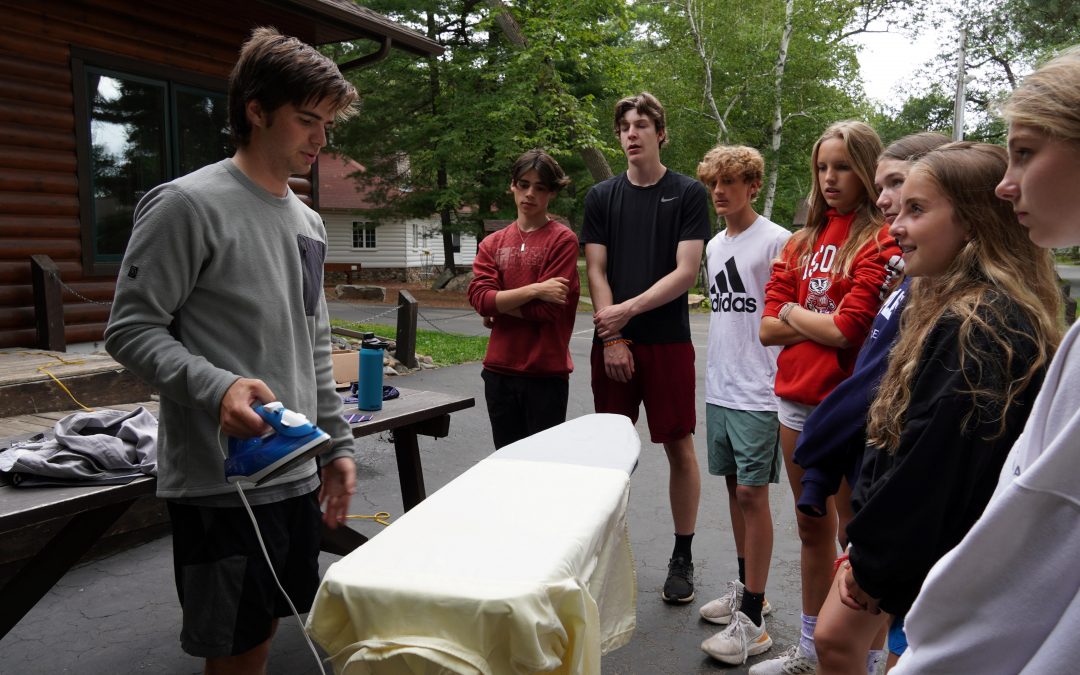Summer camp is a rite of passage for many kids, but packing for it can feel like scaling a mountain. How do you fit a summer’s worth of items into one bag? And how do you ensure your child will find their favorite t-shirt when they need it? Fear not! With the right summer camp packing hacks, you can turn this daunting task into a smooth experience.
Key Takeaways
- Master the packing list and use efficient storage techniques to optimize space.
- Pack weather-ready solutions, label items for personalization, and include toiletries & hygiene essentials.
- Stay connected & entertained with pre-addressed envelopes, card games & books. Use camping sleep aids for comfort.
1 – Master the Packing List

A successful summer camp packing experience commences with a meticulously planned camp packing list. Most camps provide a packing list as a guide, so make sure to consult it early to avoid last-minute shopping stress. Even if your child is going to the same camp they attended last year, don’t assume the packing list hasn’t changed.
Engaging your child in the packing process not only instills a sense of responsibility but also aids their adaptation to camp life as they remember where they stowed their belongings. To help your child stay organized at camp, consider using packing cubes. These zip-up pouches help categorize items, making them easier to find. For instance, storing all t-shirts or socks in one cube can save your child precious time when getting ready for activities.
When selecting luggage, consider a large wheeled duffel bag. It’s easy to transport and flexible to fit in tight storage spaces in cabins. Brands such as Pack for Camp and Eagle Creek are recognized for their robust and spacious duffel bags.
2 – Efficient Clothing Storage

Maintaining organization at camp extends beyond having a comprehensive packing list. It’s also about how you store the items in your bag. Packing cubes are a game-changer in this regard. They compartmentalize your child’s luggage, making it easier for them to find what they need without rummaging through the entire bag.
An alternate method to neatly store clothes involves using Ziploc bags. These are perfect for keeping outfits together and storing toiletries that might leak. For younger campers, consider rolling each complete outfit and securing it with a rubber band. This way, they don’t have to think about matching tops and bottoms, saving them time and reducing stress.
For camps offering open shelving or under-bunk-bed storage, aim to keep your child’s clothes orderly folded in stacks. To prevent towels and bedding from getting mixed up with other items, pack them in Ziploc XL Flexible Totes. These are super durable and can fit multiple items, making them perfect for summer camp.
3 – Weather-Ready Solutions
The unpredictable nature of summer camp adventures often includes sudden rain showers or exceptionally hot days. To be prepared for all weather conditions, pack your child’s clothes in plastic. This not only protects their clothes from getting wet but also makes it easier to pack wet bathing suits or towels.
For toiletries, select travel-sized, leak-proof bottles such as Wedama. They’re compact and easy to carry around. For showers, don’t forget to pack flip flops or water shoes. These will protect your child’s feet from fungal or bacterial infections and keep their feet dry.
Remember to include weather-appropriate clothing in the packing list. This includes two swimsuits for lake or pool activities and a sun hat for protection against the sun’s harmful rays. For bug protection, consider packing a non-toxic, Deet-free bug repellent like the Green Natural Mosquito Repellent wrist and ankle bands.
4 – Labeling and Personalization
Losing items is a common occurrence at summer camps. To avoid this, mark all your child’s possessions, ranging from clothes to water bottles. Iron-on labels are perfect for clothing items because they’re durable and won’t come off in the wash.
Making your child’s camp space feel like home can also help them adjust to camp life. Think about including personal items such as a favorite pillow or a snug blanket. Remember to label these as well to ensure they find their way back home at the end of camp.
Another technique to individualize your child’s camp experience involves preparing letter-writing materials. Pre-addressed and pre-stamped envelopes, as part of their letter writing supplies, will make it easier for your child to write home about their amazing camp experiences.
5 – Space-Saving Techniques

Efficient packing entails optimally utilizing space. One way to do this is by rolling clothes and towels instead of folding them. This technique not only saves space but also prevents wrinkles.
Another space-saving tip is to use packing cubes. These handy tools compartmentalize your bag, allowing you to fit more items without making it look cluttered. Keep in mind that it’s good to leave a bit of extra space in the bag for any items your child might want to bring home from the camp store.
Refrain from overpacking. Motivate your child to interchange their outfits and re-wear their favorite t-shirt or shorts multiple times. This not only saves space but also makes unpacking a lot easier.
6 – Toiletries and Hygiene Essentials
Maintaining cleanliness at camp is pivotal for a healthful and enjoyable camping experience. To stay organized, organize your child’s toiletries in a shower caddy or hard-plastic toiletry organizer. This will make it easier for them to carry their toiletries to and from the shower.
Pack essentials like:
- soap
- shampoo
- toothbrush
- toothpaste
- hairbrush
For girls who might experience their first period at camp, packing the necessary supplies can help them feel more prepared. To prevent lice, consider packing a lice-repelling shampoo and conditioner like Fairy Tale Haircare Rosemary Repel.
Don’t forget to include a laundry bag for dirty clothes and a trash bag. This will not only keep your child’s living area clean but also make it easier to sort through laundry once they’re back home.
7 – Staying Connected and Entertained
Maintaining contact with home during camp can alleviate feelings of homesickness. Encourage your child to write home by packing pre-addressed and pre-stamped envelopes. This will make it easier for them to share their camp experiences with you.
For entertainment, consider packing card games or books. Games like Exploding Kittens or Sushi Go are not only fun but also a great way to make new friends at camp. Remember to check the camp rules before packing electronic devices, as many camps have strict rules regarding their use.
Remember to include a journal in your packing. This will not only keep your child entertained but also serve as a keepsake of their camp memories.
8 – Comfort and Sleep Enhancements
Ensuring a sound night’s sleep is pivotal to fully enjoy the camping experience. Enhance sleep comfort by packing sleep aids like:
- A mini-fan, which can be a real lifesaver during hot nights
- A sleep mask, which can help your child sleep soundly amidst the noise and light of shared sleeping quarters
- Earplugs, which can block out unwanted noise
These sleep aids, including a sleeping bag, will help you and your family have a restful night’s sleep while camping.
For nighttime navigation, it’s a good idea to pack a headlamp or flashlight. Consider choosing one with a super-low firefly mode like the ThruNite Archer 2A V3. This mode preserves night vision and is perfect for locating items under the bunk without disturbing other campers with a bright beam.
Consider including a pillow protector in your packing to safeguard your child’s cherished home pillow from dampness and pests.
9 – Preparing for Post-Camp Unpacking
The conclusion of camp doesn’t signify the termination of your packing responsibilities. Preparing for post-camp unpacking can make the transition back home smoother. Start by including a copy of the packing list in your child’s luggage. This will help ensure that all items are repacked on the final day of camp.
Upon return, sort through your child’s items room by room. Create different bins or labeled areas for each category: keep, donate, and throw away. This will not only make unpacking easier but also help you assess what items your child actually used at camp and what can be left out next time.
Keep in mind that the conclusion of camp simply marks the commencement of another adventure. With these smart packing hacks, you and your child can look forward to a stress-free start to their next summer camp adventure, including an exciting sleepaway camp experience at an overnight camp, guided by experienced camp counselors.
Summary
In conclusion, packing for summer camp doesn’t have to be a daunting task. With the right strategies and tools, you can ensure your child has everything they need for an unforgettable camp experience. From mastering the packing list to preparing for post-camp unpacking, these smart summer camp packing hacks can help make the process stress-free and even fun.
Frequently Asked Questions
How do you pack for summer camp?
Pack boxes with the necessary items such as toiletries, sunscreen, sunglasses, goggles, a poncho, a reusable water bottle, a baseball hat and books to enjoy during downtime. That way, you’ll be well-prepared for summer camp!
What not to bring to summer camp?
It is important to inquire beforehand what items are not allowed in the summer camp, such as food items, alcohol, pets, inappropriate reading materials, hairsprays, perfume, and cosmetics. Avoid bringing these items to ensure a safe and enjoyable stay.
How can I make camping packing easier?
To make camping packing easier, stick to the essentials and use checklists, repackage items, use dry bags for all weather, meal prep in advance, and pack a portable washing machine. This will help you keep organized and ensure you don’t forget anything.
How can I help my child stay organized at camp?
Encourage your child to be involved in the packing process and provide them with packing cubes for better organization. This will help them stay organized at camp.
What should I pack for weather changes at camp?
Pack waterproof clothing, plastic bags for storing wet items, and a sun hat for protection against the sun to account for potential weather changes at camp.

